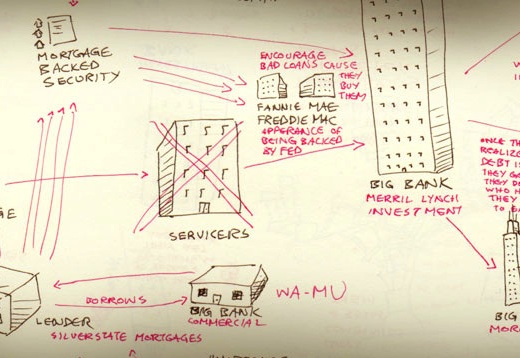At last month’s Fall 2011 graduation ceremony, Graduate Media Design alumnus Jonathan Jarvis GMD ’09 received Art Center’s prestigious Young Alumni Innovator Award for his innovative professional and creative work.
While at Art Center, Jarvis made a splash with The Crisis of Credit Visualized, a video he created which entertainingly explained the nuts and bolts behind the economic crisis of 2008 using easy-to-understand language and engaging imagery. The video became an Internet sensation and has been viewed millions of times since Jarvis first placed it online.
Just one week after graduating, Jarvis was hired by Google’s Creative Lab unit as one of the original Google Five. Currently a designer for the company, he has worked on several high profile projects for the search giant, including Androidify, the YouTube Symphony and a Google-powered love story that ran during the Super Bowl.
In addition to receiving the Young Alumni Innovator Award, Jarvis also delivered the evening’s commencement address to the Fall 2011 graduates, during which he elaborated both on The Crisis of Credit Visualized and what he took away from his Art Center experience. Here are highlights from his speech:
On lessons learned at Art Center:
“As you think about the road ahead, you’ll no doubt feel many things. I remember when I graduated from the Master’s program here a little less than three years ago, I was sitting where all of you are today, thinking about that road. I’ve been asked to tell you my story today, and how circumstances allowed me a brief glimpse of that road before I was ready to walk it. At least I thought that I wasn’t ready to walk it. But my time at Art Center had done something to me, something that made me ready. I can’t tell you exactly how it happened, or precisely when it occurred, but it did. I’m sure of it. The challenges you faced here, both personal and academic, and the ideas that you saturated in, have had a deep impact on you, deeper than you realize right now. You may not see it now, but it might manifest in an unconscious manner, like a muscle memory you’ve forgotten you developed. Something inside of you has changed, and you’ve grown more than you’ve recognized.”
On what inspired The Crisis of Credit Visualized:
“I had some studio space down at South Campus that I called the bunker because it had no windows and really thick concrete walls. I was sitting in the bunker, listening to NPR and I heard that Lehman Brothers, one of the biggest banks in the country, had just gone bankrupt. I also heard the term “subprime mortgage” for the 500th time, and I still didn’t know what that meant. So instead of working on my master’s thesis, I thought that it was the perfect time to learn what a subprime mortgage was. And I quickly discovered that to learn what a subprime mortgage was, you need to learn what a prime mortgage is. And to learn what that is, you need to understand defaulting and bankruptcy and so on. And while I was learning about all of this, a strange thing happened to me. I became fascinated.”
On the power of design:
“I started reading and watching everything available about the credit crisis. And surprisingly, for something that was so relevant, there was no basic introduction for someone who wasn’t versed in finance. Then I had this realization that, as a designer, I had the ability to turn around and explain everything I just learned to someone who, just like myself a few weeks ago, didn’t know anything about finance. And this was an amazing feeling. It was the first time that I personally realized the power of design. And it was also my first realization that what I had been learning in school was actually applicable to the world at large.”
On going viral:
“In my sixth and final term and I wanted to make a short film about the credit crisis in a very simple way. So I said to myself that I would work really hard for one week, crank the video out, it would be out of my system, and I would move on. About four weeks later, it was starting to shape up, but it was still far from what I felt was ready. I had already sunk almost half of the semester into making this film and I had to do something quick, so I threw together a website. I put the film on it, and I called it The Crisis of Credit. I sent it to my professors, some friends and a few blogs. Surprisingly they watched it. And they started watching it a lot. And then more people watched it, and started to share it. Before I knew it, it had been viewed millions of times. And I couldn’t believe it. The response was far bigger than anything I had ever imagined. Back when ‘viral’ was still a cool word, my film was going viral. And it was all because I had made something I just wanted to watch myself when I started this process.”
On glimpsing life after school:
“I suddenly started getting lots of email and my phone would ring with unidentified numbers. I was getting a lot of attention, and I loved it at first. And then everybody wanted to know what my agenda was. They wanted to know my design philosophy. What did I plan to do next? Everyone started making demands on my time. I was forced to talk to the world outside of school and to find myself as a designer before I felt ready to define myself to anybody. Even myself. I couldn’t handle it. But somehow, I did. That muscle memory kicked in. I somehow responded to all the emails. I somehow answered all the questions. And somehow said what I wanted to do without sounding completely stupid.”
On the next move:
“The next thing I knew I was at the finish line. It was graduation day and I thought, wait a second, what’s going on? Wasn’t everything supposed to be sorted out by now? Wasn’t I supposed to have a job? Wasn’t the next move supposed to be clear? I just managed to get through this crazy situation and I thought that meant that I was ready. But I was sitting there, and I certainly didn’t feel ready. I spent most of graduation day wondering when do you feel ready? And it was about a week later and I was on the phone with a man named Andy [Berndt] from Google. He’d seen the video and he was telling me about a new group that he was putting together in New York to find new ways to use Google and YouTube and Chrome. I told him it sounded fascinating, but that I wasn’t sure that I was ready. And then I immediately thought to myself, what are you doing? You just told a prospective employer that you don’t feel ready for the job! And then he said to me, ‘Nobody ever feels ready. But if the spaceship lands in your backyard and the door opens, you get in.’ So I got in.”
On not being ready:
“Over the past three years I’ve been on a team that’s found ways to use YouTube to let people anywhere in the world audition to play with the London Symphony Orchestra, that’s used only Google Search to tell a love story during the Super Bowl, and that’s visually redesigned all of Google. I’m on a team that every day asks me to do things that I don’t feel ready to do. And all of you will be asked to do the same. Because you are going to go on to do things that have never been done before. On your road ahead, you will build new types of products that have never been built before. You will work in industries that did not even exist when you started here. One of you may even go on to create an entirely new industry. And you’re never going to be ready for that.”
Art Center Alumni Awards, which provide the College an opportunity to publicly recognize the talent, service and design influence of our alumni, were also bestowed upon Lou Danziger ADVT ’48 for a lifetime of professional and creative achievement and Wendy McNaughton FINE ’99 for realized humanitarian design impact. See all the award winners and the Fall 2011 graduation ceremony in it’s entirety here.










